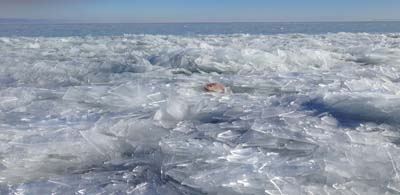Teeth of Lake Superior by Annika Lise Hendrickson
3rd Place - Natural Category
School: Minnetonka High School
Teacher: Kimberly Hoehne
During the winter in Northern Minnesota, sheets of ice on Lake Superior are continuously pushed into the shore, often resulting in piles of ice shards as seen in the picture above. Both rapid-moving wind and strong tidal waves contribute to the force required to push the ice farther onshore. Waves are classified as the transfer of energy through a medium that causes the particles to move up and down. However, a horizontal ebb and flow can still be seen at the edges of this body of water, causing the ice shards to pile on top of previous shards. The two types of water waves that are seen in this phenomenon are tidal waves and wind waves. Wind waves occur when the friction between the moving air molecules and the water causes turbulence. This friction causes a pressure differential, causing the water to rise and sink and thus creating a wave. Wind waves are known to be generally choppy and irregular, which results in the different shaped ice shards and disorganization.The second type of wave causing this is the generic tidal wave. Tidal waves are caused by the gravitational pulls of the sun and moon, and are easily predictable. The waves move at a speed slow enough for new ice near the shore to form before collapsing over the old ice, which creates the effect seen in the photo. Both types of waves contribute to this formation.



